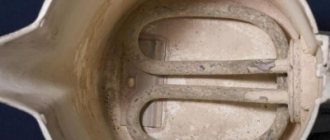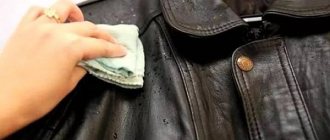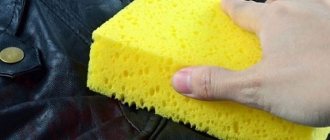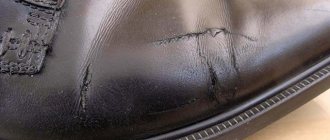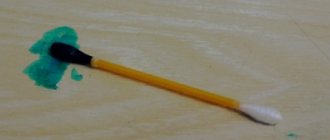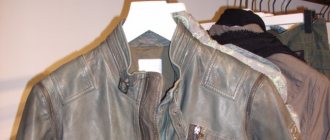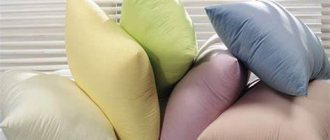Most people are confident that only dry cleaning professionals can remove mold. In reality, they are wrong, because there are a number of folk methods for removing mold that can be used at home. Financial costs are minimal, and the result will be pleasantly surprising, so before contacting specialists, you can find out how to deal with mold and we will help with this.
Top 6 remedies for mold on leather products
Mold spots have different colors, depending on the type of fungus, and sizes that increase as they grow. If you find mold, do not put off cleaning until later. The faster the problem is resolved, the less likely the fungus will reappear.
How to remove mold from a leather jacket? First of all, inspect the clothing completely (don’t forget the lining) and find any areas of infection. You can clean it at home in the bathroom, but it is better to do it in the fresh air. If this is not possible, then close the bathroom door tightly to prevent spores from entering the rest of the living space.
Treatment with soap solution
A gentle option for removing fungus. To prepare it, dilute liquid soap with warm water and apply the solution to the jacket with a soft brush. Rub in gently, applying light pressure. After cleaning, rinse off the soapy solution with clean water.
How else to clean a leather jacket from mold at home? In addition to soap solution, there are several other quite effective means:
- ammonia;
- mouthwash;
- hydrogen peroxide;
- laundry soap;
- laundry conditioner.
You need to be careful with hydrogen peroxide. This product bleaches, so we do not recommend cleaning dark-colored clothing.
Causes of mold in shoes
Mold on shoes in the house can develop in two ways:
- if there is already a mold mycelium in the house, then during the development of spores (microscopic “seeds”) are carried by air currents, penetrating into the smallest cracks;
- spores or part of the mycelium could remain on the shoes after visiting the street, forest, or room contaminated with mold fungi.
Mold is often found on shoes made from natural materials:
- leather;
- suede;
- textile.
Mold on shoes
However, mold does not hesitate to settle on shoes made of leatherette or other synthetic materials.
If boots or dress shoes are moldy, most likely there is a suitable microclimate in the room:
- high humidity;
- uneven heat distribution;
- improper ventilation.
In general, if shoes become moldy during storage, we can conclude that they were not cleaned properly:
- the shoes were poorly washed and not cleaned (not cleaned enough);
- remained under-dried (wet);
- was stored without access to fresh air (in a tight plastic bag, in a closed box, box).
Rules of care
It is easier to prevent the appearance of fungal colonies than to deal with their global size. To protect your skin from mold, follow several rules for caring for your product:
- Periodically wipe the product with ammonia in combination with soap solution. At the end of the procedure, rinse off the product with clean water, wipe the skin dry and treat with castor oil or cream.
- To treat thin leather, use the same solution, only apply it with a soft sponge or cloth so as not to damage the structure and color of the material.
This treatment not only prevents the appearance of fungus, but also removes accumulated dust and minor dirt.
Tips and tricks
- Wipe leather items with vinegar at the beginning and end of the season.
- After cleaning, make sure the quality of the treatment - there should not be a trace of fungus left, otherwise the clothes will again be covered with an unsightly coating.
- Keeping your closet clean is also important. If there is fungus in the closet and on other items of clothing, the leather jacket will also be affected by spores.
When there are damp spots in a room (on the ceiling, floor), spores spread through the air and settle on all surfaces, including clothing. In this case, mold removal must be comprehensive, that is, starting from the walls and ending with the clothes.
If your favorite jacket suddenly begins to smell unpleasantly or the leather jacket you purchased exudes a persistent odor, you should think about removing the stench. The first and most reliable way is to have the jacket cleaned, but this method is expensive, so just order the item to be “deperfuminated.”
It is not always possible to turn to professionals. Methods and recipes that people have been using for decades come to the rescue.
Traditional methods for removing odors from skin
There are many ways to get rid of unpleasant odors using improvised means at home. The most popular methods are using vinegar, soda, coffee, and weathering. Any of the methods will help solve the problem only with strict adherence to technology.
Attention! The skin needs constant nutrition. After using any product, pamper your jacket by wiping it with linseed or castor oil. The pores will expand, skin breathing will improve, and the unpleasant odor will leave the item faster. .
How to clean a leather jacket at home?
Clothing made from genuine leather is stylish, expensive and durable, but it looks extremely noble and fashionable only if properly cared for. Perhaps one of the most common and favorite types of clothing made from genuine leather is the jacket - it is worn by teenagers, brutal men, and elegant women: leather jackets are available in a variety of styles. But love for them leads to constant or, at least, frequent wearing, and constant wearing leads to contamination, which is unlikely to be avoided.
If, for a number of reasons, it is not possible to entrust a leather jacket that has become dirty or has lost its shine to professional craftsmen and products, then it is quite possible to put a shine on your favorite item at home: you can save money and experiment within reason. In addition, since it is assumed that the purchased jacket will last more than one season, it is important to remember the rules for regular care of a leather product, the observance of which will simplify its cleaning in the future.
Criteria for the selection and use of funds
When choosing a means to destroy mold on clothes, you need to consider:
- Fabric type.
- The color of the item.
- Degree of infection.
- Processing method.
Cost also plays an important role.
Important! When choosing such products, be sure to familiarize yourself in detail with their composition, warnings and limitations, and instructions for use.
Mold does not like high temperatures and chemicals. Fabrics are also quite demanding in terms of methods and means of influencing them:
Linen and cotton clothes in white or pastel shades can be safely boiled with the addition of chlorine-containing chemical products.- Wool and synthetic fabrics react negatively to high temperatures, as this destroys their structure. Stain removers are used to clean them from mold.
- silk items from mold using turpentine or ammonia. Stain removers may harm delicate fabrics.
- Leather clothing is not afraid of mechanical stress, but is sensitive to chemicals, so it is better to remove mold from it with a stiff brush and soap solution.
- Bright items may lose their color when exposed to chemical reagents, so before use you should carefully study the rules for using the product and conduct a spot test of the fabric reaction on the wrong side of the clothing.
- Fabrics that are slightly contaminated with fungus can be saved by using regular laundry detergent, but stain removers and bleaches will have to deal with a harmful substance that is firmly ingrained into the structure of the material.
Vinegar
This product has a strong smell, but it will go away along with the others. Mode of application:
- prepare a solution of white vinegar and water in equal quantities (1:1 ratio);
- try using the resulting product on the back of the skin;
- moisten a clean cloth with the solution and wipe the surface of the jacket;
- as an option, moisten the leather surface using a spray bottle;
- ventilate the product.
Another method with vinegar that eliminates persistent odor:
- draw hot water (10-15 cm) into the bath;
- add a glass of white vinegar;
- hang a jacket over the bathroom;
- to achieve a guaranteed result, you can add boiling water to the water;
- close the door for two hours;
- dry the jacket naturally and ventilate it.
Getting rid of unpleasant odors
To remove the smell of sweat absorbed into the skin, you need to fill the bath with hot water and pour a glass of vinegar into it. Hang the jacket inside out on hangers over the water and leave it in a tightly closed bathroom. After 2 hours of hanging over the steam, the smell of sweat will disappear. A jacket made of thin leather can be damaged by excess moisture. On such a product, it is better to sprinkle unpleasant-smelling areas with baking soda moistened with water. If the jacket is saturated with tobacco smoke, sprinkle wet soda over the entire lining. When the powder dries, shake it off. Freshly ground coffee combats any unpleasant odors well. They need to sprinkle the jacket, and after a day shake off the powder. Helps to cover up the smells and aroma of orange peel - the skin is rubbed with the outer part of the peels. Important! The last 2 products are not suitable for light-colored jackets - coffee and oranges can stain the skin.
How to deal with salt stains?
White spots appear on leather products just as often. The main reason for their appearance is rain and snow. Unfortunately, even the most fashionable leather jacket is a capricious thing and does not tolerate precipitation. Therefore, it is better for owners of such products to stock up on an umbrella. However, things don't always go according to plan. If salt stains do appear, you need to know how to remove them.
Folk remedies
Among the folk remedies we can mention vinegar. You need to take a soft towel or rag, moisten it and wipe the stains. However, after such a procedure there will be an unpleasant aroma that is difficult to remove. To get rid of it, you can grease your jacket with orange peel. This method will not only eliminate the odor, but will make the skin soft and shiny. True, the method is not suitable for light-colored products .
Professional products
There are many professional products available for removing salt stains. Among them are:
- Leather sponge (adds shine and removes fine abrasions);
- Foam cleaner (allows you to restore shine and former beauty);
- Wax for leather (softens leather, eliminates cracks and abrasions);
- Moisture-repellent spray (protects against moisture, preventing streaks).
Removing difficult and old stains
A heavily soiled jacket can be cleaned and lubricated with special products for leather products. Factory-made creams and impregnations do not harm the skin, giving it brightness, shine, softness and water-repellent properties. An economical alternative to store-bought stain removers are proven folk methods for cleaning leather jackets.
Grease stains, paint, mold
Shiny collars and cuffs or small greasy stains on the jacket can be cleaned with a cotton pad with warm glycerin, makeup remover milk, dishwashing detergent solution, and damp baking soda. Old or large grease stains can be cleaned with a cloth moistened with gasoline, turpentine, alcohol or vinegar. To prevent the jacket collar from getting dirty longer, it is advisable to wear a neckerchief or high-necked clothing underneath. Gasoline, white spirit, acetone or turpentine will help get rid of paint stains or mold on the skin. Important! The effect of solvents must first be tested in an inconspicuous place. After treatment, the surface of the dark jacket should be wiped with orange peel, and the light jacket with lemon juice, dried and lubricated with glycerin. Jackets made of thin leather and leatherette cannot be cleaned with gasoline. Grease stains diluted with water, chalk, talc or starch. A thick paste should be applied to the dirt, left for 15-30 minutes and brushed off with a clothes brush. Lubricate cleansed skin with castor oil.
Ink stains
Traces of ballpoint and gel pens, felt-tip pens are cleaned from the skin with a cotton swab soaked in medical alcohol or warm glycerin. You can remove ink stains with salt. Wet salt is poured onto the contaminated area and left for 1-2 days. Then the salt is removed, and the skin is treated with turpentine and lubricated with castor oil. Important! Do not rub salt into the skin - hard crystals destroy it.
Salt stains
Salt stains on the skin after rain or snow are cleaned with a napkin soaked in table vinegar or a solution of liquid soap.
Newspaper/wrapping paper
The method is simple. The leather product is wrapped in a layer of newspaper or wrapping paper for several days. The texture of newspapers is soft, porous, it easily absorbs all odors, freeing the skin from them. It is possible that in this case, complete removal will require two or three repetitions of the manipulations.
Absorbs odors well and is safe for the skin. To eliminate the odor, we follow the algorithm:
- put the jacket in a pillowcase or large plastic bag;
- treat with a thin layer of soda outside and inside;
- close the package;
- leave for 12-24 hours;
- remove from the package;
- Carefully remove chemical deposits using a vacuum cleaner with a furniture attachment.
Baking soda can also be used in another way. Rub a thick paste of water and soda into the lining of the jacket and leave until completely dry. Then shake off any excess product or remove it with a soft brush. Sodium carbonate will absorb odors and carry them away.
How to remove mold
Do not forget that a leather jacket is made of natural material. Therefore, mold may not appear on it if it is not stored correctly. More on this later. Now we should figure out how to clean a leather jacket at home in this case?
The first step is to assess the extent of the damage. If most of it is already covered with mold, then no matter how pitiful the thing is, it is better to get rid of it. Few people know, but it has a detrimental effect on humans. If there is only a small amount of dirt, you can remove it with gasoline. To do this, it is enough for them to wipe the places where mold has appeared. After this procedure, an unpleasant odor will remain, which lemon peel will help get rid of.
In addition to folk remedies, dry cleaning employees can help in the fight against mold. They certainly know how to get rid of it once and for all. In addition, they will completely restore your leather jacket without the risk of ruining it.
Do not forget that gasoline is a very aggressive solvent.
Was this article helpful?
- Methods for combating mold on skin and place of procedure
- Recommendations
- How to eliminate the smell of mold from leather products?
Most people are confident that only dry cleaning professionals can remove mold. In reality, they are wrong, because there are a number of folk methods for removing mold that can be used at home. Financial costs are minimal, and the result will be pleasantly surprising, so before contacting specialists, you can find out how to deal with mold and we will help with this.
Eliminate sweat odor
The skin easily absorbs all odors, so the smell of sweat will persist, and simple weathering will not do. Let's call on the entire arsenal of available tools to help:
- soda or vinegar - proceed as described above;
- ammonia - dilute with water (a tablespoon of ammonia per glass of water), add a little liquid soap and gently wipe both the leather surface and the lining with a soft cloth;
- citrus fruits - can only be used for dark-colored products. The axillary and collar areas are rubbed with fresh fruit peel. After drying, wipe these places with a damp cloth, then dry.
- essential oils - add a few drops to the soap solution and wipe the product thoroughly.
Continuous care
Regular care of a leather jacket does not involve daily cleaning, rubbing and painting - not at all: it is enough just to pay attention to the jacket from time to time in those places where it is most susceptible to contamination. You see that the sleeves, fastener bar, places near the buttons and pockets do not look as we would like - it’s time to take action.
Caring for a leather jacket should be regular: in the future, this will save effort, time and money on restoring the attractive appearance of the product.
The simplest thing you can do is to clean the surface of the jacket from light dirt and dust. The sequence of actions when performing this procedure is as follows:
You will need an ordinary soap solution with a slight addition of ammonia. A soft flannel cloth or non-abrasive sponge is soaked in the resulting solution, and the jacket is treated with gentle, gentle movements over the entire surface or in areas of contamination. After “soaping”, the surface of the leather jacket is washed off with clean running water and wiped dry (do not use excessive physical force - this can stretch and damage the leather). Dry, clean skin is lubricated with castor oil or a special cream intended for natural leather.
This simple cleaning procedure is effective provided that there are no “difficult” contaminants on the surface of the jacket - it will only refresh the jacket by washing away daily dirt, stains from raindrops, etc.
Getting rid of shine and greasy skin
Dust and splashes of dirt in the off-season are not the worst thing that can happen to a leather jacket: all this can be easily removed. The lower part of the sleeves, the fold of the collar, the fastener and the areas of the pocket entrances are more persistently contaminated - these are those places that have constant contact with the human body and surrounding objects.
Cleaning the collar
On a women's jacket, the dirt on the collar is not so obvious and this is understandable: men's sweat and fat are released more intensely, and therefore when cleaning a men's leather jacket, special attention should be paid to the collar:
Lay the jacket out on a flat, hard surface with the collar straightened out. Alcohol is used as a cleaning agent, and the tool used to treat the collar will be a cotton pad or soft rag soaked in it. Using gentle movements, the collar is treated with alcohol, special attention is paid to the most contaminated fold area and tips. The collar treated with alcohol is wiped with lemon juice - it will dissolve grease and dissolve the unpleasant greasy odor. If you don’t have lemon juice, you can use the outer side of the orange zest - it will additionally refresh and deepen the color of the jacket. The surface of the collar is softened with glycerin, and the jacket is placed on hangers until the collar is completely dry.
Performing this procedure monthly will help avoid greasy collar, which will be difficult to remove even with professional means.
Try to wear a scarf or neckerchief - this is not only stylish and fashionable, but will also save your collar from contact with the skin and frequent cleaning
Pockets, sleeves, fastener
Other areas (the entrance to the pocket, the placket or the area around the closure, as well as the sleeves in the lower and side parts), which are subject to daily contamination no less intensively, are cleaned in the same way as the collar. Perhaps monthly cleaning of these areas will not be enough - then you should do it more often.
Fighting the aroma of tobacco
If the above methods do not work, for dark things we will use regular coffee:
- the jacket is placed in a bag;
- sprinkled with ground or instant product;
- kept covered for a couple of days;
- After removal from the bag, the powder particles are removed by shaking off.
This method does not help - lemon comes to the rescue:
- spray a mixture of juice and water (1:1) over the entire surface;
- leave for 2-3 hours;
- Remove the unabsorbed part of the applied product with a sponge soaked in a soap solution;
- make sure that no streaks remain on the surface;
- wipe the jacket with a dry cloth;
- dry in natural conditions.
Bright skin
Hydrogen peroxide is perfect for removing traces of mold from products on light leather:
- Dampen the stained areas and leave for fifteen minutes.
- Afterwards, rinse the item.
You may have to repeat the steps if the result is not achieved after the first time.
Important! You can also use bleach. To do this, mix it with water and washing powder. Dampen the brush with the resulting liquid and work on the dirty areas.
Mold control
Externally, fungal spores look like small spots of dirt. Under no circumstances should this problem be started. The best time to deal with mold is as soon as you notice it.
Important! If dirt is not removed in time, there is a high probability that it will remain with you forever.
Location
Where can the product be cleaned? Of course, you can do this right in the house, but it is best if you have the opportunity to carry out the procedure outside. This way, fungal spores will not be able to get on other things.
Soap solution
If you are afraid of ruining something in an attempt to return it to its previous state, then the soap and water method is the ideal option for you:
- Prepare a soap solution. To do this, you need to mix a little water at room temperature and liquid soap.
- Use a soft bristle brush to remove dirt.
- Rub the solution in smooth and careful movements so as not to accidentally damage the product.
- After the result is achieved, remove any remaining soap with clean water and let the product dry at room temperature.
Ammonia
An incredibly effective remedy when it comes to removing mold from skin is ammonia. All you need to do:
- Dilute it in equal proportions with water.
- Then soak a cotton pad or a small piece of cloth in the resulting solution and go over all areas of contamination.
- At the end of the procedure, it is necessary to rinse the product.
Important! It is best to test before you decide to use ammonia. To do this, use a small amount on a small area of the item. This is quite important, because you can never be sure how the material will behave.
Mouthwash
Alternatively, you can use a mouthwash to remove mold from your skin. This method is not so popular, however, it is very effective. Soak a cotton pad in the product and use it to work on moldy areas. You will be pleasantly surprised by the results.
Bright skin
Hydrogen peroxide is perfect for removing traces of mold from products on light leather:
- Dampen the stained areas and leave for fifteen minutes.
- Afterwards, rinse the item.
You may have to repeat the steps if the result is not achieved after the first time.
Important! You can also use bleach. To do this, mix it with water and washing powder. Dampen the brush with the resulting liquid and work on the dirty areas.
colored skin
Laundry soap is an ideal product for removing mold from colored leather. All that is needed:
- Lightly moisten the item with water and thoroughly rub the soap into the stained areas for several minutes to form a film.
- Let the product dry in the sun for 1-2 hours, then rinse off any remaining soap.
The result will pleasantly surprise you.
Air conditioner
It is very important to complete the cleansing process correctly. Using leather conditioner is mandatory. You can purchase it at any specialized store.
Use a small amount immediately after cleaning the mold from the product. The fact is that the condition of your item after cleaning may deteriorate somewhat. The conditioner will help preserve the original color and extend its service life.
Tips and tricks:
- If you do not want mold spores to form on the surface one day, then as a preventive measure it is recommended to periodically wipe the leather product with vinegar.
- Once the result is achieved, be sure to make sure that there are no traces of mold left. Otherwise, you will have to face the problem of eliminating it again in the near future, the plaque will make itself felt again.
- Be sure to take proper care of your leather item and the place in which it is stored. By following this rule, you will never have to look for ways to combat mold.
Important! Alternatively, you can wash the item in the washing machine, adding laundry detergent and a small amount of leather conditioner.
Ammonia
An incredibly effective remedy when it comes to removing mold from skin is ammonia. All you need to do:
- Dilute it in equal proportions with water.
- Then soak a cotton pad or a small piece of cloth in the resulting solution and go over all areas of contamination.
- At the end of the procedure, it is necessary to rinse the product.
Important! It is best to test before you decide to use ammonia. To do this, use a small amount on a small area of the item. This is quite important, because you can never be sure how the material will behave.
How to wash properly
White eco-leather gets dirty quickly, products made from it can be washed, but you should not make rough movements or rub with force. Stains on things made of artificial material should be removed immediately after they appear, using a soft sponge or foam rubber.
Soap solution
Eco-leather is cleaned in different ways, dirt is removed using household products, but formulations containing chemicals are not used, as they can react and damage the material. To wash white artificial leather, you need to soak a sponge in liquid and then apply the product.
To remove grease stains from upholstered furniture, strollers or skirts:
- The bucket is filled with water.
- Add crushed laundry soap and beat it into foam.
- Foam rubber is moistened in the prepared composition and applied to the contaminated area.
Eco leather is wiped with the soft side of the sponge. After removing traces of grease, the material is dried with a cloth.
Recommendations for cleaning in special cases
You can accidentally spill coffee or tea on clothes or furniture upholstery, or stain artificial leather with berries, paint, or blood. To wash away fruit stains, remove food residues, and clean chewing gum, various methods are used.
Marks from pens and felt-tip pens
When a family has small children, drawings made from paste and markers appear on the white upholstery of a sofa or sofa. To remove such “paintings,” add fine salt to the soap solution, apply the composition for several hours, and rinse with clean water.
Nail polish remover
If this method fails to remove pen marks, you have to use alcohol and clean the felt-tip pen with turpentine. Treating the paste with nail polish remover that does not contain acetone helps to remove the paste. The solvent negatively affects the structure of eco-leather; it is used when other means have not given a positive result.
Hair fixation spray
It is necessary to clean products from ink and paste using gentle methods, but if they turn out to be ineffective, aggressive liquids are used. To get rid of fresh marks, hairspray is sprayed over the surface of the artificial leather. After a few minutes, it, along with the felt-tip pen and gel, is removed with a napkin.
Leather polish and solvent for polyurethane glue
Baking soda, ethyl alcohol, and citric acid remove ink stains and traces of markers; ballpoint pen paste contains wax, which cannot be cleaned with such products.
Conditioner or leather polish is applied to the surface of the sofa upholstery; after 5 or 10 minutes, the contaminated area is wiped with a solvent for polyurethane glue.
Drink Stains
Tea or coffee spilled on eco-leather should be immediately blotted with a dry cloth, a paper napkin, or sprinkled with salt, which should be collected when it absorbs the liquid. Traces of compote or soda are wiped off:
- citric acid;
- hydrogen peroxide;
- diluted vinegar.
After cleaning the stains of tea, beer or lemonade, the artificial leather is treated with a soap solution. The surface of the material is dried with a cloth or towel.
Food contamination
Residues from food, greasy deposits, traces of chocolate, honey on products and upholstery made of eco-leather are removed with laundry soap and dishwashing liquid.
Stains from berries, grass
Light-colored clothes made of artificial material can easily be covered with strawberries or currants, or green plants. You can also get rid of these contaminants. Traces of berries are washed off with citric acid or citrus fruit juice, and bleached with hydrogen peroxide.
Blood
It is not recommended to soak eco-leather furniture upholstery, skirts and dresses, car covers; stains are washed off with laundry soap, but old traces of blood are cleaned with a cotton swab dipped in ammonia. Fresh stains are washed with cool water.
Nail polish or paint
Eco-leather clothes stained with brilliant green should not be thrown away. You can get rid of such stains and return the product to its original appearance. Wipe off the antiseptic and acrylic paint with the liquid that is used to seal the nail polish. The work must be done carefully so as not to damage the structure of the material.
Chewing gum and plasticine
Mask stains on light-colored eco-leather furniture by wiping with milk mixed with raw protein. Toothpaste is applied to the stained area, left for a quarter of an hour, and removed with a napkin. To remove stuck chewing gum and clean the surface of plasticine, wipe the material with a cotton swab, dipping it in alcohol.
Gouache and watercolor
Children paint the upholstery of an eco-leather sofa not only with felt-tip pens and a ballpoint pen, but also with water-soluble paints. To remove a drawing from a watercolor, traces of gouache, dip a melamine sponge into liquid soap, and wipe the problem areas.
Oil paint
Fresh stains on light artificial leather can be blotted with a paper towel, and then, by combining a liter of water with 30 ml of dishwashing gel, remove any remaining dirt. Dried oil paint is wiped with a sponge soaked in turpentine.
